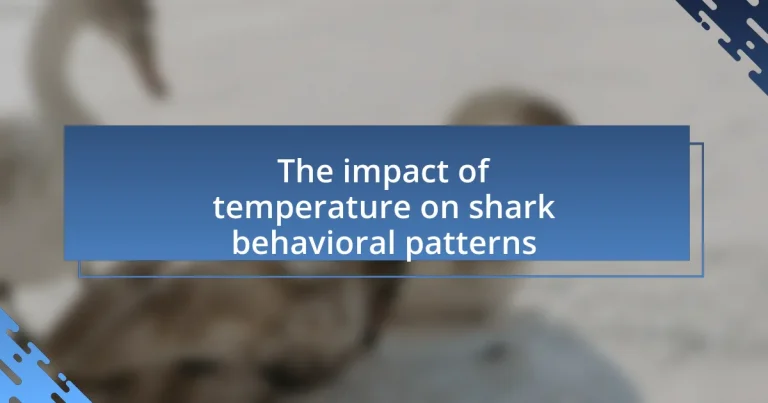The article examines the significant impact of temperature on shark behavioral patterns, focusing on aspects such as movement, feeding, and reproduction. It highlights how temperature influences shark metabolism, migratory behavior, and sensory perception, with specific temperature ranges affecting their activity levels and reproductive cycles. Additionally, the article discusses the broader ecological implications of temperature changes on shark interactions with other marine species and the potential consequences of climate change on their habitats and behaviors. Strategies for mitigating these impacts and practical steps for studying temperature effects on sharks are also outlined.

What is the impact of temperature on shark behavioral patterns?
Temperature significantly influences shark behavioral patterns, affecting their movement, feeding, and reproductive activities. As ectothermic animals, sharks rely on environmental temperatures to regulate their body functions. For instance, warmer waters can increase metabolic rates, leading to heightened activity levels and altered foraging behaviors. Research indicates that species like the great white shark exhibit changes in migratory patterns in response to temperature fluctuations, often moving to cooler waters during warmer months to maintain optimal physiological conditions. Additionally, temperature variations can impact breeding cycles, with some species timing their reproduction to coincide with specific thermal conditions that enhance offspring survival.
How does temperature influence shark movement and migration?
Temperature significantly influences shark movement and migration patterns. Sharks are ectothermic animals, meaning their body temperature is regulated by the surrounding water temperature, which affects their metabolic rates and behavior. For instance, warmer waters can enhance shark activity and trigger migrations toward breeding or feeding grounds, as seen in species like the great white shark, which migrates to warmer coastal areas during specific seasons. Research indicates that changes in sea surface temperatures can lead to shifts in shark distribution, with studies showing that increased temperatures correlate with the presence of certain shark species in previously cooler regions, highlighting their adaptability to temperature variations.
What specific temperature ranges affect shark migratory behavior?
Shark migratory behavior is significantly influenced by temperature ranges between 18°C to 30°C (64°F to 86°F). Within this range, many shark species, such as the great white and tiger sharks, exhibit increased movement and migration patterns in search of optimal feeding and breeding grounds. Research indicates that temperatures below 18°C can lead to reduced activity and migration, while temperatures above 30°C may also deter sharks due to stress and decreased oxygen levels in warmer waters. This temperature sensitivity is critical for understanding their migratory routes and habitat preferences.
How do sharks respond to sudden temperature changes in their environment?
Sharks exhibit physiological and behavioral changes in response to sudden temperature changes in their environment. When faced with temperature fluctuations, sharks may alter their swimming patterns, depth preferences, and feeding behaviors to maintain optimal body temperature and metabolic function. For instance, studies have shown that species like the great white shark can migrate to deeper, cooler waters when surface temperatures rise, demonstrating their adaptability to thermal stress. Additionally, research indicates that temperature changes can influence shark reproductive cycles and prey availability, further impacting their behavior.
What role does temperature play in shark feeding behavior?
Temperature significantly influences shark feeding behavior by affecting their metabolic rates and prey availability. Warmer water temperatures generally increase shark metabolism, leading to heightened activity levels and feeding frequency. For instance, studies have shown that species like the great white shark exhibit increased hunting behavior in warmer waters, as their physiological processes become more efficient. Additionally, temperature impacts the distribution and abundance of prey species, which in turn affects shark feeding patterns. Research indicates that as ocean temperatures rise, certain prey may migrate to cooler areas, prompting sharks to adjust their feeding strategies accordingly.
How does water temperature affect prey availability for sharks?
Water temperature significantly affects prey availability for sharks by influencing the distribution and behavior of their prey species. Warmer water temperatures often lead to increased metabolic rates in fish and other marine organisms, which can alter their migration patterns and spawning cycles. For instance, studies have shown that many fish species, which are primary prey for sharks, tend to move to cooler waters during warmer months, thereby reducing their availability in areas where sharks typically hunt. Additionally, temperature changes can affect the abundance of zooplankton, a crucial food source for smaller fish, which in turn impacts the entire food web. This relationship highlights the importance of water temperature in shaping the ecological dynamics that determine prey availability for sharks.
What are the feeding patterns of sharks at different temperatures?
Sharks exhibit varying feeding patterns based on temperature, with warmer waters generally increasing their metabolic rates and feeding frequency. For instance, studies have shown that species like the great white shark tend to feed more actively in temperatures ranging from 15°C to 25°C, as these conditions enhance their hunting efficiency and prey availability. Conversely, in colder waters below 15°C, sharks may reduce their feeding activity significantly, as their metabolism slows down, leading to less frequent hunting and consumption of prey. This relationship between temperature and feeding behavior is supported by research indicating that temperature influences not only the sharks’ energy requirements but also the distribution and abundance of their prey species.
How does temperature impact shark reproduction and breeding habits?
Temperature significantly impacts shark reproduction and breeding habits by influencing the timing and success of reproductive events. Warmer water temperatures can accelerate the reproductive cycle of many shark species, leading to earlier mating seasons and increased reproductive rates. For instance, studies have shown that species like the blacktip reef shark exhibit enhanced reproductive output in warmer waters, with higher litter sizes reported in temperatures above 25 degrees Celsius. Additionally, temperature affects the development of embryos; higher temperatures can lead to faster gestation periods but may also increase the risk of developmental abnormalities. Research indicates that optimal temperature ranges are crucial for successful breeding, as deviations can negatively affect reproductive success and juvenile survival rates.
What temperature conditions are optimal for shark mating?
Optimal temperature conditions for shark mating typically range between 20°C to 25°C (68°F to 77°F). Research indicates that many shark species exhibit increased mating activity within this temperature range, as warmer waters can enhance metabolic rates and reproductive behaviors. For instance, studies have shown that species like the blacktip reef shark (Carcharhinus melanopterus) engage in courtship and mating more frequently when water temperatures are within this optimal range, supporting the idea that temperature significantly influences their reproductive patterns.
How does temperature affect the gestation period of sharks?
Temperature significantly influences the gestation period of sharks, with warmer water typically leading to shorter gestation times. Research indicates that increased temperatures can accelerate embryonic development in species such as the blacktip reef shark, where gestation can be reduced from 10 to 12 months in cooler waters to as little as 8 to 10 months in warmer conditions. This phenomenon is attributed to the metabolic rates of the embryos, which rise with temperature, thereby speeding up their growth and development.

What are the physiological effects of temperature on sharks?
Temperature significantly affects the physiological processes of sharks, influencing their metabolism, growth, and reproductive functions. As ectothermic animals, sharks rely on external temperatures to regulate their body heat, which directly impacts their metabolic rate; for instance, higher temperatures can increase metabolic rates, leading to faster growth and higher energy demands. Conversely, lower temperatures can slow down their metabolism, resulting in reduced activity levels and energy conservation. Research indicates that temperature variations can also affect the reproductive cycles of sharks, with optimal temperatures promoting successful breeding and development of embryos. Studies have shown that species like the blacktip reef shark exhibit altered reproductive timing in response to temperature changes, highlighting the critical link between temperature and physiological responses in sharks.
How does temperature affect shark metabolism?
Temperature significantly affects shark metabolism by influencing their physiological processes and energy expenditure. As ectothermic animals, sharks rely on external temperatures to regulate their body heat, which directly impacts their metabolic rate. For instance, higher water temperatures generally increase metabolic rates, leading to enhanced activity levels and feeding rates, while lower temperatures can slow down metabolism, resulting in reduced activity and energy conservation. Research indicates that species like the tiger shark exhibit increased metabolic rates at temperatures above 20°C, demonstrating a direct correlation between temperature and metabolic activity.
What metabolic changes occur in sharks at varying temperatures?
Sharks experience significant metabolic changes at varying temperatures, primarily characterized by alterations in their metabolic rate and energy expenditure. As ectothermic animals, sharks rely on external temperatures to regulate their body heat, leading to increased metabolic rates at higher temperatures, which can enhance their activity levels and feeding rates. Conversely, lower temperatures result in decreased metabolic rates, reducing their energy expenditure and activity. Research indicates that for every 10°C increase in temperature, the metabolic rate of sharks can increase by approximately 2 to 3 times, demonstrating a direct correlation between temperature and metabolic activity. This relationship is crucial for understanding how temperature fluctuations can impact shark behavior, including foraging and migration patterns.
How does temperature influence the energy expenditure of sharks?
Temperature significantly influences the energy expenditure of sharks by affecting their metabolic rates. As ectothermic animals, sharks rely on the surrounding water temperature to regulate their body temperature and metabolic processes. Research indicates that higher temperatures generally increase metabolic rates, leading to higher energy expenditure, while lower temperatures can slow down metabolism and reduce energy needs. For instance, a study published in the Journal of Experimental Marine Biology and Ecology found that the metabolic rate of juvenile blacktip reef sharks increased by approximately 20% with a temperature rise of 5 degrees Celsius. This relationship highlights how temperature variations can directly impact the energy dynamics and overall behavior of sharks in their aquatic environments.
What are the effects of temperature on shark sensory perception?
Temperature significantly affects shark sensory perception by influencing their ability to detect environmental stimuli. As ectothermic animals, sharks rely on external temperatures to regulate their physiological processes, which can alter sensory functions such as olfaction, electroreception, and vision. For instance, research indicates that warmer temperatures can enhance olfactory sensitivity, allowing sharks to detect prey more effectively, while extreme heat may impair their sensory capabilities, leading to decreased hunting efficiency. Additionally, temperature fluctuations can affect the functioning of the ampullae of Lorenzini, which are critical for detecting electrical fields generated by prey. Studies have shown that optimal temperature ranges enhance sensory perception, while deviations from these ranges can lead to diminished sensory acuity, impacting overall hunting success and behavioral patterns.
How does temperature impact a shark’s ability to detect prey?
Temperature significantly impacts a shark’s ability to detect prey by influencing their sensory systems and metabolic rates. As ectothermic animals, sharks rely on external temperatures to regulate their body functions; warmer waters can enhance their sensory perception, particularly the ability to detect electrical signals emitted by prey. Research indicates that increased temperatures can improve the performance of the ampullae of Lorenzini, specialized electroreceptors in sharks, allowing them to locate prey more effectively. Conversely, extreme temperature fluctuations can impair these sensory systems, reducing their hunting efficiency.
What sensory adaptations do sharks have to cope with temperature changes?
Sharks possess specialized sensory adaptations, such as the ampullae of Lorenzini, to detect temperature changes in their environment. These electroreceptors allow sharks to sense minute electrical fields generated by other organisms, which can be influenced by temperature variations. Additionally, sharks have a well-developed lateral line system that detects water movement and pressure changes, helping them navigate and hunt in varying thermal conditions. Research indicates that these adaptations enhance their ability to locate prey and avoid predators in fluctuating temperatures, ultimately influencing their behavioral patterns and survival strategies.

What are the broader ecological implications of temperature on shark behavior?
Temperature significantly influences shark behavior, affecting their distribution, feeding patterns, and reproductive cycles. As ocean temperatures rise due to climate change, sharks may migrate to cooler waters, altering local ecosystems and predator-prey dynamics. For instance, studies have shown that species like the great white shark are shifting their ranges poleward in response to increasing sea temperatures, which can lead to changes in the abundance and distribution of prey species. This shift can disrupt existing marine food webs and impact fisheries, as sharks play a crucial role in maintaining the balance of marine ecosystems. Additionally, temperature changes can affect shark reproductive success, with warmer waters potentially leading to earlier breeding seasons or reduced pup survival rates, further influencing population dynamics and ecosystem health.
How does temperature influence shark interactions with other marine species?
Temperature significantly influences shark interactions with other marine species by affecting their distribution, behavior, and predation patterns. As water temperature rises, sharks may migrate to cooler areas, altering their interactions with prey and competitors. For instance, studies have shown that warmer temperatures can lead to increased metabolic rates in sharks, prompting them to hunt more actively, which can intensify predation on smaller fish and invertebrates. Additionally, temperature changes can affect the reproductive cycles of both sharks and their prey, leading to shifts in population dynamics and interactions. Research indicates that species like the great white shark exhibit altered hunting strategies in response to temperature variations, impacting their ecological relationships within marine ecosystems.
What are the effects of temperature on predator-prey dynamics involving sharks?
Temperature significantly influences predator-prey dynamics involving sharks by affecting their metabolic rates, hunting efficiency, and prey availability. As water temperature increases, sharks often exhibit heightened activity levels, which can enhance their predation success. For instance, studies have shown that warmer temperatures can lead to increased foraging behavior in species like the great white shark, resulting in a higher capture rate of prey such as seals. Conversely, extreme temperature fluctuations can stress both sharks and their prey, potentially disrupting established predator-prey relationships. Research indicates that temperature changes can also alter the distribution of prey species, impacting the overall dynamics of the ecosystem.
How do temperature changes affect shark competition with other species?
Temperature changes significantly affect shark competition with other species by altering their distribution, behavior, and prey availability. As ocean temperatures rise, many shark species may migrate to cooler waters, leading to increased competition with other marine predators that inhabit those areas. For instance, studies have shown that warmer temperatures can enhance the metabolic rates of sharks, making them more aggressive and competitive for food resources. Additionally, temperature fluctuations can impact the abundance and distribution of prey species, further intensifying competition among sharks and other predators. Research indicates that species such as the great white shark have shifted their ranges in response to changing temperatures, which can lead to overlapping territories with other apex predators, thereby increasing competition for food and habitat.
What are the potential consequences of climate change on shark behavior?
Climate change can significantly alter shark behavior, primarily through rising ocean temperatures and changing prey availability. Increased water temperatures can lead to shifts in shark distribution, as species may migrate to cooler waters to maintain their preferred thermal ranges. For instance, studies have shown that species like the great white shark are moving poleward in response to warming seas. Additionally, changes in ocean temperature can affect the abundance and distribution of prey species, which in turn influences shark foraging patterns and reproductive behaviors. Research indicates that these behavioral changes can impact shark populations and their roles in marine ecosystems, highlighting the interconnectedness of climate change and marine life dynamics.
How might rising ocean temperatures alter shark habitats?
Rising ocean temperatures can significantly alter shark habitats by shifting their distribution and affecting their breeding and feeding grounds. As water temperatures increase, many shark species tend to migrate towards cooler, deeper waters or higher latitudes, which can disrupt existing ecosystems and food chains. For instance, studies have shown that species like the great white shark are moving northward along the U.S. East Coast due to warmer waters, impacting local marine biodiversity and fisheries. Additionally, warmer temperatures can lead to habitat degradation, such as coral bleaching, which affects species that rely on coral reefs for shelter and food.
What strategies can be implemented to mitigate the impact of temperature changes on sharks?
To mitigate the impact of temperature changes on sharks, strategies such as habitat protection, establishing marine protected areas, and implementing adaptive management practices can be employed. Habitat protection ensures that critical breeding and feeding grounds remain intact, which is essential as sharks may shift their ranges in response to temperature fluctuations. Establishing marine protected areas can help safeguard these habitats from human activities that exacerbate stress on shark populations. Adaptive management practices, informed by ongoing research and monitoring, allow for timely adjustments to conservation strategies based on observed changes in shark behavior and distribution due to temperature variations. These strategies are supported by studies indicating that habitat loss and human interference significantly affect shark populations, highlighting the need for proactive measures in conservation efforts.
What practical steps can be taken to study the impact of temperature on shark behavior?
To study the impact of temperature on shark behavior, researchers can implement controlled laboratory experiments, field studies, and telemetry tracking. Controlled laboratory experiments allow for the manipulation of temperature while observing changes in shark behavior, such as feeding rates and social interactions. Field studies can involve monitoring sharks in their natural habitats across different temperature gradients, providing real-world data on behavioral adaptations. Telemetry tracking enables researchers to gather data on shark movements and habitat use in relation to varying water temperatures. These methods collectively provide a comprehensive understanding of how temperature influences shark behavior, supported by empirical data from various studies in marine biology.

